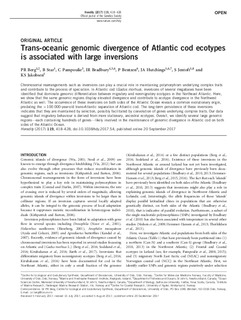| dc.contributor.author | Berg, Paul Ragnar | |
| dc.contributor.author | Star, Bastiaan | |
| dc.contributor.author | Pampoulie, Christophe | |
| dc.contributor.author | Bradbury, Ian R. | |
| dc.contributor.author | Bentzen, Paul | |
| dc.contributor.author | Hutchings, Jeffrey | |
| dc.contributor.author | Jentoft, Sissel | |
| dc.contributor.author | Jakobsen, Kjetill Sigurd | |
| dc.date.accessioned | 2018-02-06T11:55:19Z | |
| dc.date.available | 2018-02-06T11:55:19Z | |
| dc.date.created | 2017-11-21T10:12:07Z | |
| dc.date.issued | 2017 | |
| dc.identifier.citation | Heredity. 2017, 1-11. | nb_NO |
| dc.identifier.issn | 0018-067X | |
| dc.identifier.uri | http://hdl.handle.net/11250/2482910 | |
| dc.description.abstract | Chromosomal rearrangements such as inversions can play a crucial role in maintaining polymorphism underlying complex traits and contribute to the process of speciation. In Atlantic cod (Gadus morhua), inversions of several megabases have been identified that dominate genomic differentiation between migratory and nonmigratory ecotypes in the Northeast Atlantic. Here, we show that the same genomic regions display elevated divergence and contribute to ecotype divergence in the Northwest Atlantic as well. The occurrence of these inversions on both sides of the Atlantic Ocean reveals a common evolutionary origin, predating the >100 000-year-old trans-Atlantic separation of Atlantic cod. The long-term persistence of these inversions indicates that they are maintained by selection, possibly facilitated by coevolution of genes underlying complex traits. Our data suggest that migratory behaviour is derived from more stationary, ancestral ecotypes. Overall, we identify several large genomic regions—each containing hundreds of genes—likely involved in the maintenance of genomic divergence in Atlantic cod on both sides of the Atlantic Ocean. | nb_NO |
| dc.language.iso | eng | nb_NO |
| dc.publisher | Nature-Springer | nb_NO |
| dc.rights | Attribution-NonCommercial-NoDerivatives 4.0 Internasjonal | * |
| dc.rights.uri | http://creativecommons.org/licenses/by-nc-nd/4.0/deed.no | * |
| dc.title | Trans-oceanic genomic divergence of Atlantic cod ecotypes is associated with large inversions | nb_NO |
| dc.type | Journal article | nb_NO |
| dc.type | Peer reviewed | nb_NO |
| dc.description.version | publishedVersion | nb_NO |
| dc.source.pagenumber | 1-11 | nb_NO |
| dc.source.journal | Heredity | nb_NO |
| dc.identifier.doi | 10.1038/hdy.2017.54 | |
| dc.identifier.cristin | 1516467 | |
| dc.relation.project | Norges forskningsråd: 179569 | nb_NO |
| dc.description.localcode | nivå1 | nb_NO |
| cristin.unitcode | 201,15,2,0 | |
| cristin.unitcode | 201,0,0,0 | |
| cristin.unitname | Institutt for naturvitenskapelige fag | |
| cristin.unitname | Universitetet i Agder | |
| cristin.ispublished | true | |
| cristin.fulltext | original | |
| cristin.qualitycode | 1 | |

